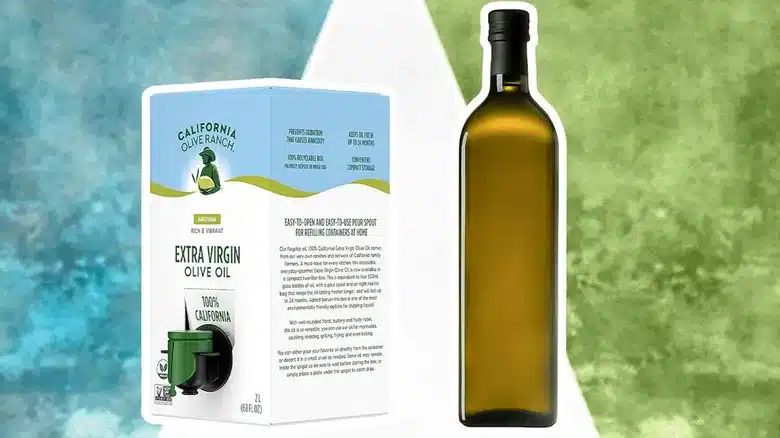
Boxed (“bag-in-box”) olive oil is quite rare to find on grocery store shelves compared to the typical bottled type. However, despite its odd appearance, olive oil stored in boxes has some impressive benefits, such as a longer shelf life and a friendlier environmental footprint.
Boxed liquids are not a new concept: they’ve been around since the 1980s and were first introduced for fruit juices and wine. Inside the cardboard box is a bag or tube containing the olive oil, connected to a tap, which dispenses the oil when opened.
In addition to holding a larger volume of olive oil, the beauty of this setup is that the inner bag is airtight. Unlike typical tinted glass bottles, which allow air to enter when uncapped, the bag in the box collapses as the oil is dispensed, keeping air infiltration to a minimum.
Because of this, the oil doesn’t oxidize or degrade as quickly, making the box an excellent option for those who like to buy cooking oil in bulk. In fact, a study from the University of Ioannina showed that boxed olive oil retains its quality for over 120 days, compared to only 80 days in tin-plated steel containers.
And, because boxed olive oil is in a container made of cardboard, it’s very lightweight, so manufacturers can ship much more olive oil per trip than with glass bottles. That not only saves money but also reduces the carbon footprint of olive oil production and shipping.
As surprising as boxed olive oil may seem, it’s not a perfect design, and a primary concern is the type of plastic used for the inner bag. These bags are usually coated with a layer of metallized film to provide an additional layer of protection for the oil against light and oxygen.
However, the film makes the bag difficult to recycle, unlike glass bottles (fortunately, some manufacturers are developing recyclable inner bags, so this won’t be an issue in the future).
But perhaps a bigger reason it hasn’t yet caught on with consumers is simply a matter of perception. Like boxed wine, most people believe that boxed olive oil is cheap and of inferior quality, compared to oil that comes in glass bottles. It doesn’t help that the box is tightly sealed, either, since you can’t look inside the bag to see the oil for yourself.
In defense of boxed olive oil, if you buy from a reputable brand, the oil inside will still taste as good as bottled oil and comes with added benefits like a longer shelf life. “The box is bad” is simply a myth!
If you’re thinking about trying boxed olive oil, here are some tips to ensure it stays fresh and flavorful. First, while the box already does a good job of protecting the oil from light and oxidation, we should store it in a cool, dry place with a constant temperature. And it’s also a good idea to clean the faucet every few days with a damp cloth to prevent olive oil residue from building up and attracting bacteria.
Finally, don’t forget to write down the date you first opened the box. In fact, according to the University of Ioannina study, it’s best to consume boxed olive oil within 120 days for maximum flavor. While the oil can still be consumed (keep an eye on the harvest and expiration dates), you may risk losing optimal flavor after this point.
Important Note: aceitedelcampo.com promotes the consumption of extra virgin olive oil for its culinary qualities and health benefits. However, no medication or current treatment should be replaced without the guidance of a healthcare professional.
ALZAYT EXPORT SL
info@aceitedelcampo.com
C/ Eduardo Bosca 19, 2-5
46023 Valencia
Subscribe to receive discounts, promotions, and news.